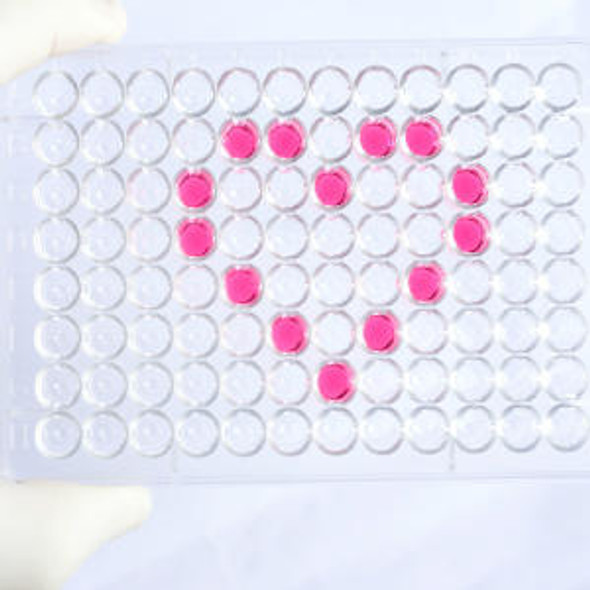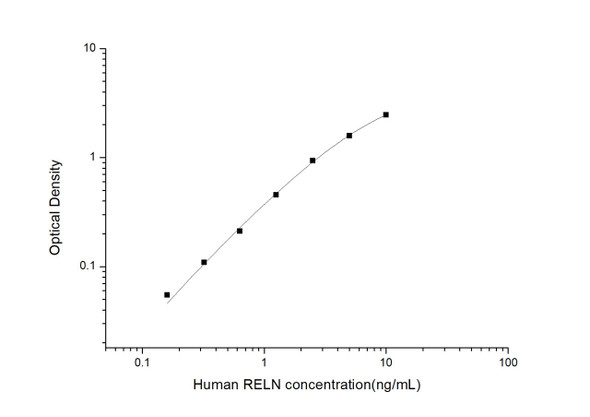Description
Human Reelin ELISA Kit
Reelin encodes a large secreted extracellular matrix protein thought to control cell-cell interactions critical for cell positioning and neuronal migration during brain development. Reelin may be involved in the development of neurodegenerative disorders such as schizophrenia, autism, bipolar disorder, and epilepsy. The Assay Genie Human Reelin ELISA is a highly sensitive assay for the quantitative measurement of Reelin in serum, blood, plasma, cell culture supernatant and tissue samples.
| Product Name: | Human Reelin ELISA Kit |
| Product Code: | HUFI01785 |
| Size: | 96 Assays |
| Alias: | RELN, Reelin, Reeler, RL |
| Detection method: | Sandwich ELISA, Double Antibody |
| Application: | This immunoassay kit allows for the in vitro quantitative determination of Human RELN concentrations in serum plasma and other biological fluids. |
| Sensitivity: | 9.375pg/ml |
| Range: | 15.625-1000pg/ml |
| Storage: | 4°C for 6 months |
| Note: | For Research Use Only |
| Recovery: | Matrices listed below were spiked with certain level of Human RELN and the recovery rates were calculated by comparing the measured value to the expected amount of Human RELN in samples. | ||||||||||||||||
| |||||||||||||||||
| Linearity: | The linearity of the kit was assayed by testing samples spiked with appropriate concentration of Human RELN and their serial dilutions. The results were demonstrated by the percentage of calculated concentration to the expected. | ||||||||||||||||
| |||||||||||||||||
| CV(%): | Intra-Assay: CV<8% Inter-Assay: CV<10% |
| Component | Quantity | Storage |
| ELISA Microplate (Dismountable) | 8×12 strips | 4°C for 6 months |
| Lyophilized Standard | 2 | 4°C/-20°C |
| Sample/Standard Dilution Buffer | 20ml | 4°C |
| Biotin-labeled Antibody(Concentrated) | 120ul | 4°C (Protect from light) |
| Antibody Dilution Buffer | 10ml | 4°C |
| HRP-Streptavidin Conjugate(SABC) | 120ul | 4°C (Protect from light) |
| SABC Dilution Buffer | 10ml | 4°C |
| TMB Substrate | 10ml | 4°C (Protect from light) |
| Stop Solution | 10ml | 4°C |
| Wash Buffer(25X) | 30ml | 4°C |
| Plate Sealer | 5 | - |
Other materials and equipment required:
- Microplate reader with 450 nm wavelength filter
- Multichannel Pipette, Pipette, microcentrifuge tubes and disposable pipette tips
- Incubator
- Deionized or distilled water
- Absorbent paper
- Buffer resevoir
| Uniprot | P78509 |
| UniProt Protein Function: | reelin: Extracellular matrix serine protease that plays a role in layering of neurons in the cerebral cortex and cerebellum. Regulates microtubule function in neurons and neuronal migration. Affects migration of sympathetic preganglionic neurons in the spinal cord, where it seems to act as a barrier to neuronal migration. Enzymatic activity is important for the modulation of cell adhesion. Binding to the extracellular domains of lipoprotein receptors VLDLR and LRP8/APOER2 induces tyrosine phosphorylation of DAB1 and modulation of TAU phosphorylation. Defects in RELN are the cause of lissencephaly type 2 (LIS2); also known as lissencephaly with cerebellar hypoplasia or Norman-Roberts syndrome. LIS2 is a classic type lissencephaly associated with abnormalities of the cerebellum, hippocampus and brainstem. Individuals with LIS2 are severely ataxic, mentally retarded and suffer from epilepsy. Belongs to the reelin family. 3 isoforms of the human protein are produced by alternative splicing. |
| UniProt Protein Details: | Protein type:Cell development/differentiation; Secreted; Cell adhesion; EC 3.4.21.-; Protease; Secreted, signal peptide; Motility/polarity/chemotaxis Chromosomal Location of Human Ortholog: 7q22 Cellular Component: extracellular space; proteinaceous extracellular matrix; cytoplasm; dendrite Molecular Function:serine-type peptidase activity; metal ion binding; protein serine/threonine/tyrosine kinase activity Biological Process: cellular morphogenesis during differentiation; axon guidance; central nervous system development; peptidyl-tyrosine phosphorylation; spinal cord patterning; neuron migration; response to pain; proteolysis; positive regulation of synaptic transmission, glutamatergic; glial cell differentiation; dendrite development; cell adhesion; layer formation in the cerebral cortex; positive regulation of TOR signaling pathway; associative learning; regulation of behavior; regulation of synaptic transmission; cerebral cortex tangential migration; hippocampus development; activation of CREB transcription factor; ventral spinal cord development; positive regulation of phosphoinositide 3-kinase cascade; positive regulation of small GTPase mediated signal transduction; positive regulation of peptidyl-tyrosine phosphorylation; long-term memory; positive regulation of protein kinase activity; brain development Disease: Epilepsy, Familial Temporal Lobe, 7; Lissencephaly 2; Epilepsy, Familial Temporal Lobe, 1 |
| NCBI Summary: | This gene encodes a large secreted extracellular matrix protein thought to control cell-cell interactions critical for cell positioning and neuronal migration during brain development. This protein may be involved in schizophrenia, autism, bipolar disorder, major depression and in migration defects associated with temporal lobe epilepsy. Mutations of this gene are associated with autosomal recessive lissencephaly with cerebellar hypoplasia. Two transcript variants encoding distinct isoforms have been identified for this gene. Other transcript variants have been described but their full length nature has not been determined. [provided by RefSeq, Jul 2008] |
| UniProt Code: | P78509 |
| NCBI GenInfo Identifier: | 1743885 |
| NCBI Gene ID: | 5649 |
| NCBI Accession: | AAC51105.1 |
| UniProt Secondary Accession: | P78509,Q86UJ0, Q86UJ8, Q8NDV0, Q9UDQ2, A4D0P9, A4D0Q0 |
| UniProt Related Accession: | P78509 |
| Molecular Weight: | 384,093 Da |
| NCBI Full Name: | reelin |
| NCBI Synonym Full Names: | reelin |
| NCBI Official Symbol: | RELN |
| NCBI Official Synonym Symbols: | RL; ETL7; LIS2; PRO1598 |
| NCBI Protein Information: | reelin |
| UniProt Protein Name: | Reelin |
| UniProt Gene Name: | RELN |
| UniProt Entry Name: | RELN_HUMAN |
*Note: Protocols are specific to each batch/lot. For the correct instructions please follow the protocol included in your kit.
Before adding to wells, equilibrate the SABC working solution and TMB substrate for at least 30 min at 37°C. When diluting samples and reagents, they must be mixed completely and evenly. It is recommended to plot a standard curve for each test.
| Step | Protocol |
| 1. | Set standard, test sample and control (zero) wells on the pre-coated plate respectively, and then, record their positions. It is recommended to measure each standard and sample in duplicate. Wash plate 2 times before adding standard, sample and control (zero) wells! |
| 2. | Aliquot 0.1ml standard solutions into the standard wells. |
| 3. | Add 0.1 ml of Sample / Standard dilution buffer into the control (zero) well. |
| 4. | Add 0.1 ml of properly diluted sample ( Human serum, plasma, tissue homogenates and other biological fluids.) into test sample wells. |
| 5. | Seal the plate with a cover and incubate at 37 °C for 90 min. |
| 6. | Remove the cover and discard the plate content, clap the plate on the absorbent filter papers or other absorbent material. Do NOT let the wells completely dry at any time. Wash plate X2. |
| 7. | Add 0.1 ml of Biotin- detection antibody working solution into the above wells (standard, test sample & zero wells). Add the solution at the bottom of each well without touching the side wall. |
| 8. | Seal the plate with a cover and incubate at 37°C for 60 min. |
| 9. | Remove the cover, and wash plate 3 times with Wash buffer. Let wash buffer rest in wells for 1 min between each wash. |
| 10. | Add 0.1 ml of SABC working solution into each well, cover the plate and incubate at 37°C for 30 min. |
| 11. | Remove the cover and wash plate 5 times with Wash buffer, and each time let the wash buffer stay in the wells for 1-2 min. |
| 12. | Add 90 µl of TMB substrate into each well, cover the plate and incubate at 37°C in dark within 10-20 min. (Note: This incubation time is for reference use only, the optimal time should be determined by end user.) And the shades of blue can be seen in the first 3-4 wells (with most concentrated standard solutions), the other wells show no obvious color. |
| 13. | Add 50 µl of Stop solution into each well and mix thoroughly. The color changes into yellow immediately. |
| 14. | Read the O.D. absorbance at 450 nm in a microplate reader immediately after adding the stop solution. |
When carrying out an ELISA assay it is important to prepare your samples in order to achieve the best possible results. Below we have a list of procedures for the preparation of samples for different sample types.
| Sample Type | Protocol |
| Serum | If using serum separator tubes, allow samples to clot for 30 minutes at room temperature. Centrifuge for 10 minutes at 1,000x g. Collect the serum fraction and assay promptly or aliquot and store the samples at -80°C. Avoid multiple freeze-thaw cycles. If serum separator tubes are not being used, allow samples to clot overnight at 2-8°C. Centrifuge for 10 minutes at 1,000x g. Remove serum and assay promptly or aliquot and store the samples at -80°C. Avoid multiple freeze-thaw cycles. |
| Plasma | Collect plasma using EDTA or heparin as an anticoagulant. Centrifuge samples at 4°C for 15 mins at 1000 × g within 30 mins of collection. Collect the plasma fraction and assay promptly or aliquot and store the samples at -80°C. Avoid multiple freeze-thaw cycles. Note: Over haemolysed samples are not suitable for use with this kit. |
| Urine & Cerebrospinal Fluid | Collect the urine (mid-stream) in a sterile container, centrifuge for 20 mins at 2000-3000 rpm. Remove supernatant and assay immediately. If any precipitation is detected, repeat the centrifugation step. A similar protocol can be used for cerebrospinal fluid. |
| Cell culture supernatant | Collect the cell culture media by pipette, followed by centrifugation at 4°C for 20 mins at 1500 rpm. Collect the clear supernatant and assay immediately. |
| Cell lysates | Solubilize cells in lysis buffer and allow to sit on ice for 30 minutes. Centrifuge tubes at 14,000 x g for 5 minutes to remove insoluble material. Aliquot the supernatant into a new tube and discard the remaining whole cell extract. Quantify total protein concentration using a total protein assay. Assay immediately or aliquot and store at ≤ -20 °C. |
| Tissue homogenates | The preparation of tissue homogenates will vary depending upon tissue type. Rinse tissue with 1X PBS to remove excess blood & homogenize in 20ml of 1X PBS (including protease inhibitors) and store overnight at ≤ -20°C. Two freeze-thaw cycles are required to break the cell membranes. To further disrupt the cell membranes you can sonicate the samples. Centrifuge homogenates for 5 mins at 5000xg. Remove the supernatant and assay immediately or aliquot and store at -20°C or -80°C. |
| Tissue lysates | Rinse tissue with PBS, cut into 1-2 mm pieces, and homogenize with a tissue homogenizer in PBS. Add an equal volume of RIPA buffer containing protease inhibitors and lyse tissues at room temperature for 30 minutes with gentle agitation. Centrifuge to remove debris. Quantify total protein concentration using a total protein assay. Assay immediately or aliquot and store at ≤ -20 °C. |
| Breast Milk | Collect milk samples and centrifuge at 10,000 x g for 60 min at 4°C. Aliquot the supernatant and assay. For long term use, store samples at -80°C. Minimize freeze/thaw cycles. |
Fill out our quote form below and a dedicated member of staff will get back to you within one working day!






